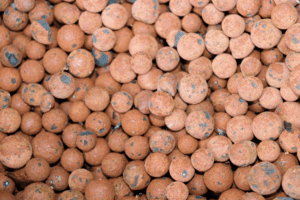Most experienced orchid growers will acknowledge that the majority of orchid culture is hydroponic in nature, as the medium is there primarily for mechanical support, and provides little, if any, nutrition to the plant, with that being provided by the nutrient solutions used.
When most folks think of hydroponics, it’s in the context of “ebb-and-flow,” nutrient film, or nutrient mist (aeroponic) culture techniques. I don’t feel that those are appropriate for orchids, due to the possibility of pathogen transport through the nutrient bath, not to mention the costs involved, so I have experimented for years in an effort to find a culture technique that provides the best conditions for the plants, as well as a minimum in labor for the grower. The following provides some semi-hydroponics basics, with more details in other articles.
I grow much of my personal collection of plants in individual-pot hydroponics, using Lightweight Expanded Clay Aggregate (LECA), in what I refer to as a “semi-hydroponic” method (don’t get hung up on the name, it’s simply a way to differentiate it from the methods I described above).
For containers, I use custom-made plastic pots (converted deli containers), but have, in the past, used painters buckets, food storage containers, trash cans, etc. – any plastic or glass container with closed bottoms. I have even used Styrofoam coolers. Those pots have two, one-quarter-inch diameter holes, right next to each other, about one inch up from the bottom on the sides. The function of the design is described below.

The medium is another key component of the culture technique; it must be inert so it won’t decompose, fairly uniform in particle size so it provides lots of free air space, and must provide good capillary (wicking) action to keep it uniformly moist. I started this culture technique using a custom “semi-hydroponic” medium, which was sponge-rock (very coarse perlite, with chunks typically 1/2″-3/4″) and coarse charcoal, mixed in about 50-50 ratio, and, although it had a reasonably long life, it was not reusable, and over time, root growth appears to break down the sponge rock, which limits air flow. After much experimenting, I have found that Lightweight Expanded Clay Aggregate (LECA) really fits the bill.

Potting is very similar to that with more traditional media, except that, instead of compressing the medium around the roots as you pot, you want to shake the pot when pouring medium around the roots, so it will get into the spaces within the root ball. Pot your plants to a normal depth. Be sure to soak the medium thoroughly (I prefer overnight) before potting. Adding a root-growth stimulant to the presoak also helps.
Note on size of medium to use: Most clay aggregate materials are available in different size grades. We recommend the coarser material – typically 8-16 mm) – for all plants. If you try growing larger plants in the fine material, the roots may fill the void spaces, suffocating themselves. Don’t be too concerned about using coarse material for small, and/or fine-rooted plants, as they seem to adapt to it quite well – it’s a moist, airy root zone environment that they love.
Watering frequency will vary with plant growth rate and ambient conditions, and may vary with the season. In fact, once a plant is well-established, it literally cannot be overwatered, and flushing the pot frequently eliminates plant waste products and returns the reservoir chemistry to its “target” values, so is an advantage. At a bare minimum, try to water before the pot dries out. We recommend feeding a somewhat dilute nutrient solution at every watering, and all of our plants get fertilizer at a nitrogen dosage of about 30-50 ppm, as we tend to water very frequently. Notice I don’t water constantly…that’s why I call it semi-hydroponic.
The watering technique is quick and easy: simply fill the pot rapidly to the top with dilute fertilizer solution. In one step it flushes and saturates the medium and refreshes the reservoir, then drains down to the level of the holes, leaving the mix nice and airy, while providing a reservoir of fresh fertilizer solution to keep it moist by capillary action.
Paphiopedilums were the first plants I experimented with, and they took to the culture technique so well, that we were encouraged to try others. In the 30+ years I’ve been experimenting, I have learned that it really isn’t the plant that determines your success with the technique, it’s how you implement it, and how the rest of your growing conditions “mesh” with S/H to provide the plants’ needs that really matters. There are folks successfully growing plants that I’ll always kill, and some I grow that very few others can…
For those of you who have a tendency to “over-pot” plants, this culture method may offer you a real “plus,” as it appears that plants do quite well in large pots. For example, several years ago I moved an Oncidium Sharry Baby ‘Sweet Fragrance’ AM/AOS from a 2″ pot of bark mix to a 12″ Semi-hydro pot, and it has bloomed reliably ever since. In September of 1997, it had 4 spikes carrying over 300 blossoms! When carrying it back to the greenhouse from the household display location (my kitchen), I dropped it, breaking the pot. To my amazement, the entire 12″ diameter by 14″ tall pot was just FULL of roots!
I know there is no “universal culture method” that is perfect for every grower and every genus, but I believe that the semi-hydroponic technique comes pretty close. When using the overall technique described above, I observe the following:
- There is always a readily available moisture and food source, eliminating the stresses put on a plant when those are lacking or only available intermittently.
- One cannot overwater, as the pot design maintains a maximum level, and the medium controls the distribution.
- Once a plant is established in the technique, root rot is virtually eliminated, as the airy nature of the medium allows plenty of air movement and gas exchange to keep the root zone fresh, and not saturated with carbon dioxide.
- There is no noticeable salt buildup, due to the dilution of the nutrients, the structure of the medium, it being constantly moist, and the flushing action of the dilute solution.
